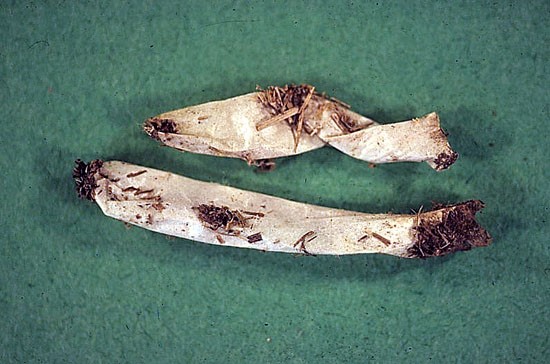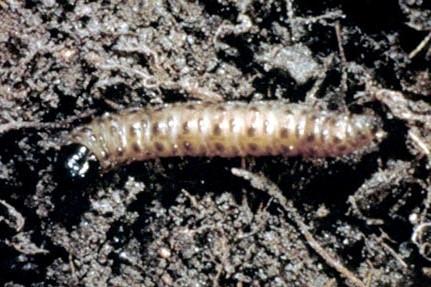Issue 6, July 1, 2021
Sod webworm
Sod webworm is a common pest of turfgrass in Illinois. They are typically seen in mid-summer and cause brown patches in the turf. In favorable conditions, large sections of a lawn could become brown. In hot, dry conditions, like those we have seen in northern Illinois, sod webworm larvae thrive and have the potential to cause more damage.
There are a few distinct characteristics that can be used to identify sod webworm injury:
- Turfgrass that appears brown and drought-stressed but does not recover with watering.
- Many birds visiting the turfgrass to feed on larvae.
- Holes in the turfgrass caused by birds feeding on the larvae.
- Finding sod webworm larvae or small silk tubes in areas with injury.


Left: Silk tube remnant of silk-lined larval burrow from burrowing sod webworm, Phil Nixon, University of Illinois at Urbana-Champaign
Right: Sod webworm larva, Phil Nixon, University of Illinois at Urbana-Champaign
If you suspect sod webworms, scout in areas with injury to determine if enough larvae are present to warrant treatment. There are two ways to scout for sod webworm larvae:
The first method is to scout injured areas by parting the grass with your hands and looking for the larvae or small green pellets of frass (insect droppings). The larvae can be tan, white, grey or green, and grow up to 1 inch long. They create silk-lined burrows in the thatch, where they reside during the day, then emerge at night to feed. In some cases, the lining of the burrows can be found. These look like small silk tubes.
The second method is to flush the larvae out of the turf. Mix a bucket of soapy water (1 tbsp dish soap and 1 gal water) and apply it evenly across 1 sq ft of turf. The soap will irritate the larvae and they will move to the surface where they can be identified (this may take 10 – 15 min).
If you find 2 – 3 larvae per sq ft of turfgrass, you can treat the area for these insects.
Control
Both chemical and biological treatments are effective in controlling sod webworm larvae. Effective organic biological controls include spinosad (Conserve), a bacterial control agent, or Steinernema carpocapsae (Biosafe), an entomopathogenic nematode. Biological control may also occur naturally. The rainy conditions in central Illinois are favorable to beneficial pathogens like microsporidia, which may control sod webworm populations without additional action from gardeners or landscape managers.
Effective chemical controls include bifenthrin (Onyx, Talstar), carbaryl (Sevin), chlorantraniliprole (Acelepryn), clothianidin (Arena), deltamethrin (Delta Gard), indoxacarb (Provaunt), lambda-cyhalothrin (Scimitar) and trichlorfon (Dylox). Some of these products are available in granular formulations which eliminates the risk of drift on to nearby flowering plants. It is important to avoid applying insecticides to clover or flowering weeds to protect the bees and other pollinators that visit the flowers.
Author:
Sarah Hughson